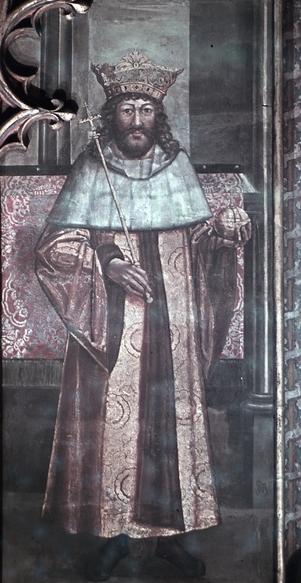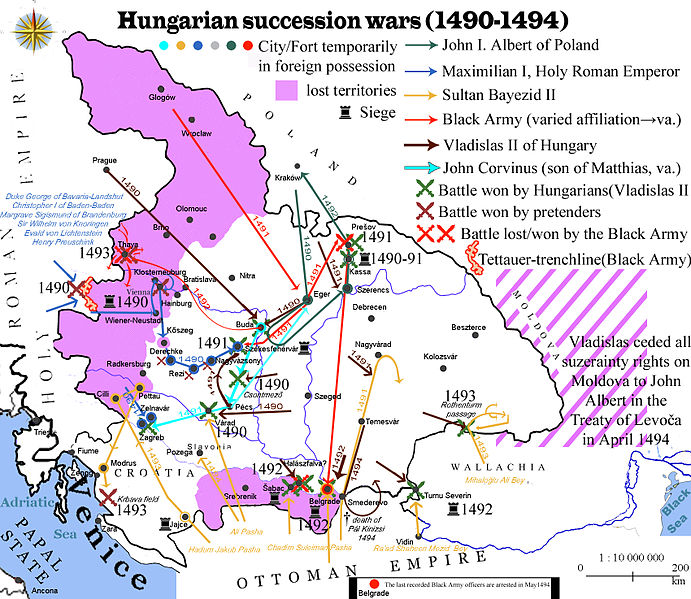<Back to Index>
- Philosopher Georg Simmel, 1858
- Writer Gheorghe Asachi, 1788
- King of Bohemia Vladislas II, 1456
PAGE SPONSOR


Vladislas II, also known as Ladislaus Jagiellon (Czech: Vladislav Jagellonský, Hungarian: II. Ulászló, Polish: Władysław II Jagiellończyk, Croatian: Vladislav II. Jagelović, Slovak: Vladislav Jagelovský); (1 March 1456, Kraków, Poland – 13 March 1516, Buda, Hungary) was King of Bohemia from 1471 and King of Hungary from 1490 until his death in 1516. He was also a knight of the Order of the Dragon.
Vladislaus was born on 1 March 1456, the son of King Casimir IV of Poland and Great Duke of Lithuania, the then head of the ruling Jagiellon dynasty of Poland, and of Elizabeth of Bohemia, daughter of Albert II of Germany. He was christened as the namesake of his grandfather King Władysław Jagiełło of Poland, maternal uncle King Ladislaus the Posthumous of Bohemia and his late paternal uncle Władysław III of Poland, an earlier king of Hungary.
He was proposed for the Bohemian throne by the widow of the previous king, George of Poděbrady, and was crowned the King of Bohemia (Vladislav) on 22 August 1471. He was crowned King of Hungary on 18 September 1490, in succession to Matthias Corvinus, who had also claimed the Bohemian throne. No regnal number was used by Vladislaus at the time, but works of reference retrospectively assigned him various ordinals for each of his kingdoms. The most usual number is II because before him there was only one Władysław on the Hungarian throne - his paternal uncle. Though counting the Hungarian and Bohemian translations of his name he was also the seventh Ladislas (VII) on the Hungarian throne and the fifth Vladislav (V) on the Bohemian throne.
The period after the death of George of Poděbrady was a time of conflict for the Bohemian throne and Vladislaus was unable to confront it. At the time of his arrival in Prague, he was only fifteen years old and significantly dominated by his advisers. The succession conflict was settled in 1479 in the Peace of Olomouc, which allowed both Vladislaus and Matthias Corvinus to use the title "King of Bohemia." Vladislaus would reign in Bohemia proper, while Matthias gained Moravia, Silesia, and the two Lusatias. The deal also stipulated that in case of Matthias' death, Vladislaus would pay 400,000 gold (contemporary currency, not "gold") for the entirety of the Bohemian lands. However, this payment was not made once Vladislaus became King of Hungary after the death of Matthias.
The "Kutnohorian deal"
in 1485 practically eliminated Vladislaus' power and granted it to the
nobles. The deal in its original form would have been in effect for 31
years, but was extended in 1512 to "all times." He was a cheerful man,
nicknamed "Vladislaus Bene" (Polish: Władysław Dobrze, Hungarian: Dobzse László, Czech: král Dobře) because to almost any request he answered, "Bene" (Latin for
"(It's) well"). During his reign (1490 – 1516), the Hungarian royal power
declined in favour of the Hungarian magnates, who used their power to
curtail the peasants’ freedom. His reign in Hungary was largely stable, although Hungary was under consistent border pressure from the Ottoman Empire and went through the revolt of György Dózsa.
On March 11, 1500 the Czech Council adopted a new municipal constitution
that limited royal power and Vladislav signed it in 1502 (hence it is
known as Vladislav municipal constitution). Additionally, he oversaw the construction (1493 – 1502) of the enormous Vladislav Hall atop the palace at the Prague Castle. He was married three times, first in 1476 at Frankfurt / Oder to Barbara of Brandenburg, daughter of Albert III Achilles, Elector of Brandenburg, child widow of Silesian Piast Henry XI of Głogów, then to the widow of Matthias, Beatrice of Naples, daughter of Ferdinand I of Naples. His third wife, Anne de Foix, was crowned on September 29, 1502 when she about 18 years of age and he was 46. She gave birth to his only surviving legitimate children, Anna of Bohemia and Hungary and Louis II of Hungary and Bohemia and died less than 4 years later in 1506, from complications resulting from
the birth of Louis. Vladislaus himself died on 13 March 1516, and was
buried in Székesfehérvár. Vladislaus'
ten year old son Louis succeeded him on the thrones of both Bohemia and
Hungary. His daughter Anna was married in 1515 to the future emperor Ferdinand of Austria, a grandson of Emperor Maximilian I Habsburg. Therefore, after the death of Louis at the Battle of Mohács, the succession devolved through Anna to the cadet line of eastern Habsburgs.